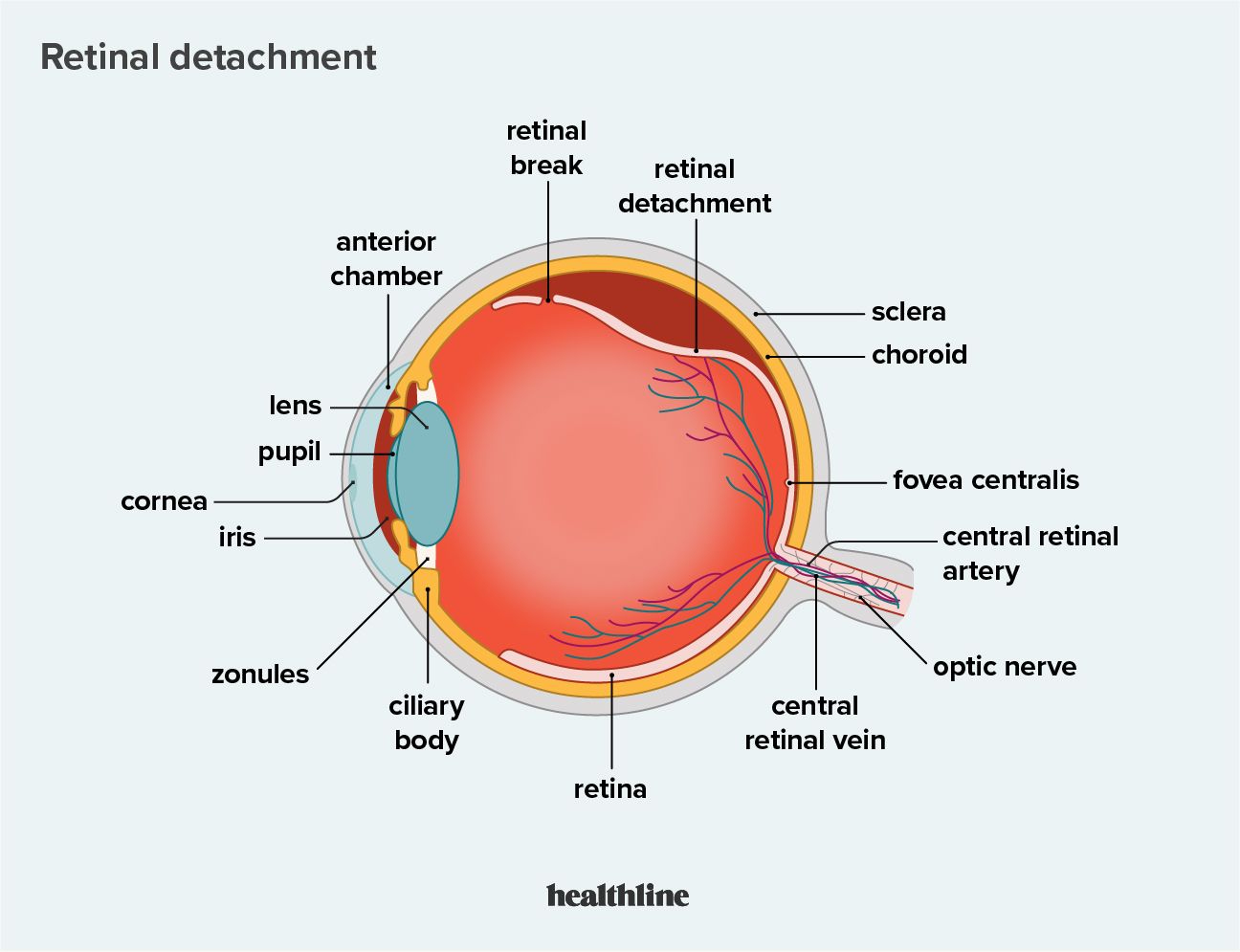A retinal tear occurs when a break develops in the layer of light-detecting cells in the back of the eye. This layer is called your retina. Retinal detachment occurs when the retina pulls away from the back of your eye.
Retinal tears and retinal detachment are medical emergencies that can cause vision loss.
Both conditions require immediate treatment to prevent long-term complications. Neither condition causes pain, so it’s important to seek immediate emergency medical attention if you develop symptoms like sudden loss of vision or seeing flashing lights.
Read on to learn more about the difference between retinal tear and detachment.

The symptoms of a retina tear and retina detachment overlap. They include the following.
Retinal tear symptoms
According to the American Academy of Ophthalmology, early signs and symptoms of a torn retina include:
- seeing flashing lights that some people describe as seeing stars, like when getting hit in the eye
- new floaters
- shadows in your peripheral vision
- a gray curtain over part of your visual field
Retinal detachment symptoms
A retinal tear can lead to retinal detachment. If it does, you might see shadows in your peripheral vision or a curtain over part of your visual field.
You might not have symptoms if only a small part of your retina is detached.
Here’s a look at the risk factors and causes of retinal tears and retinal detachment.
Retinal detachment causes and risk factors
About
Retinal detachment is usually caused by
- a family history
- serious eye injury
- eye surgery
- diabetic retinopathy
- extreme nearsightedness
- posterior vitreous detachment
- retinoschisis and other eye diseases
Retinal tear causes and risk factors
Retinal tears have the same risk factors as retinal detachment.
Some eye doctors use the term retinal holes interchangeably with retinal tears. Retinal holes are typically smaller and are caused by thinning of your retina. They’re less likely to cause retinal detachment.
Medical emergencyBoth retinal detachment and retinal tear are medical emergencies that can cause vision loss. It’s critical to get immediate medical attention if you have symptoms of either condition. Go to the nearest emergency room if you think you may have symptoms of either one.
An eye doctor can check for a retinal detachment or retinal tears with a dilated eye exam. During this test, they give you eye drops to widen your pupil and examine the back of your eye. If they need more information, they may perform an ultrasound or optical coherence tomography.
Here’s a look at the treatment options for retinal tears and detachment.
Retinal detachment treatment
Treatment for retinal detachment depends on the underlying cause and how much of your retina is detached. Options include:
- laser surgery
- freezing treatment (cryotherapy)
- other surgeries, such as:
- vitrectomy to remove and replace the fluid in your eye
- pneumatic retinopexy, where bubbles of gas are injected into your eye
- scleral buckling, where a small band pushes your retina and eye together
Learn more about surgery for retinal tears and detachments.
Retinal tear treatment
Retinal tears are typically treated with cryotherapy, in which the retina is frozen to induce scar tissue around the tear. Low-risk tears in people without symptoms might not require any treatment.
Here’s a look at the recovery of retinal tears and detachment.
Retinal tear recovery
Retinal tears often have an excellent recovery.
In a 2021
Retinal detachment recovery
Recovery from retinal detachment surgery often takes 2–6 weeks. Treatment is ultimately successful in about
Aging increases your chances of developing retina tears and detachment. Although you can’t prevent aging, you can take other precautions to protect your eyes, such as:
- wearing protective eye gear when doing activities with a risk of eye injury
- going to the eye doctor or emergency room as soon as you notice changes to your vision
- taking precautions to avoid traumatic eye injury
- minimizing processed sugar consumption to reduce your risk of diabetes
Here are some frequently asked questions people have about retinal tears and detachment.
Which is worse: a torn or detached retina?
A detached retina is more severe than a retinal tear. Detachment can range from partial to complete.
Can a retinal tear heal on its own?
Small retinal tears may heal on their own without treatment. It’s important to seek medical attention any time you develop potential symptoms like sudden vision loss or the development of floaters.
How long is it before a torn retina becomes detached?
The rate at which a torn retina progresses to a detached retina varies. Some tears never progress, even without surgery.
How long before retinal detachment causes blindness?
Permanent blindness can onset within hours to days after retinal detachment, depending on factors like the extent of your injury and what caused it.
Learn more about how long it takes after retinal detachment to go blind.
A retinal tear is a break in your retina. A retinal detachment is when your retina pulls away from the back of your eye.
Both retinal tears and detachment are emergencies that require immediate medical attention. It’s important to see a doctor right away if you develop symptoms like sudden vision loss or the development of new floaters.
